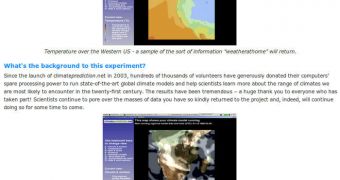Starting today, November 19, anyone who is interested in climate sciences, and wants to help scientists get a better understanding of what's in store for our future can do so from their own computers, at home.
The procedure for doing so is very simple. All you have to do is download a simple installer from the website of the project, called weatherathome.net. Anyone with a computer and an Internet connection can participate.
What you will be doing is essentially donating a portion of your computer's processing power to science, so that experts can conduct climate models while benefiting from a lot of computing power.
Participants can select whichever sections of the project they are interested in the most, or may choose to take part in models covering their specific area exclusively.
The investigation is being conducted so that scientists can better inform authorities and the general public about the frequency of extreme weather events, which current models show will increase in the near future.
These changes to Earth's atmosphere and its cycles is being generated by the vast amount of pollution humankind is placing in the air each single day. The simulations conducted through this project seek to quantify the effects of all those chemicals.
With the aid of the public, the team behind this endeavor hopes to be able to determine the number of dangerous heatwaves, floods and hurricanes that will strike in various parts of the world over the coming years, Our World reports.
Data collected in this endeavor will add to knowledge obtained via the climateprediction.net website, which has been in operation since 2003, and which has already modeled the planet's climate for 92 million years.
What separates the new project from its predecessor is the fact that it will center on producing regional climate models, which will include weather and temperature predictions, as well as possible wind and precipitation levels.
“Regional models can simulate weather features like fronts and storms and how they interact with the physical environment,” explains the head of regional modeling at the Met Office’s Hadley Center, Dr. Richard Jones. He is also a part of the climateprediction.net team.
“With the help of the public, we can run the model many more times than we could possibly do even with a supercomputer, so we can literally count one-in-100-year weather events to see how climate change is affecting weather risks,” adds Dr. Myles Allen.
The expert holds an appointment as the head of the climate dynamics group at the University of Oxford, and is also the principal investigator for the climateprediction.net project.
“It is also much more environmentally friendly to do these calculations using ‘recycled’ processor time on PCs than buying a massive supercomputer, a warehouse to put it in and an air-conditioning plant as well,” he adds.

 14 DAY TRIAL //
14 DAY TRIAL //